The Brontoichthyan Form
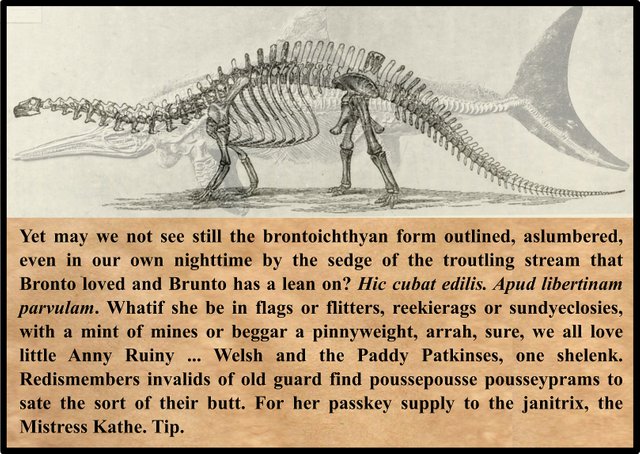
In the last article we saw how the landlord of The Mullingar House, asleep in bed beneath a patchwork quilt, was likened to the mythical Irish giant Finn MacCool interred in the Dublin landscape, or to Lemuel Gulliver sleeping on the coast of Lilliput. Or, perhaps, to one of those beached whales that Stephen recalls in Ulysses, when he is walking along Sandymount Strand:
A school of turlehide whales stranded in hot noon, spouting, hobbling in the shallows. Then from the starving cagework city a horde of jerkined dwarfs, my people, with flayers’ knives, running, scaling, hacking in green blubbery whalemeat. (Joyce 1922:45)
Finn’s head is buried beneath the Hill of Howth, his ithyphallus in the Wellington Monument in the Phoenix Park, and his two feet under a pair of hills near Castleknock in the west. At the end of the previous paragraph, he fades from view before he can be eaten by Stephen’s starving horde of jerkined dwarfs and melts into the landscape: now the Hill of Howth is his head, the Wellington Monument is his hardon, and those two hills out in Castleknock are his two feet.
In Finnegans Wake, the landscape is often identified with characters of the book:
- HCE is Dublin, and the Hill of Howth
- ALP is the River Liffey
- The Four Old Men are the Four Provinces of Ireland
- Shem and Shaun are a tree and a stone on the Left and Right Banks of the Liffey
- Issy is Chapelizod
- The Maggies, Issy’s 28 classmates, are the Magazine Fort in the Phoenix Park
First Draft Version
For once, Joyce’s first draft of this paragraph is fairly complete, differing only slightly from the published version:
We may see the brontoichthyan form outlined, even in our nighttime by the side of the troutlet stream that bronto loved and loves. What though she be in flags & flitters, rowdyrags or sundayclosies, with a mint of money or never a hapenny, yerra, we all love little Annie Ruiny, or I mean to say lobble Nanny, when under her brella, through piddle & poddle, she ninnygoes nannygoes nancing by. There! Brontolone sleeps & snores. The cranial head, castle of his reason, look yonder. Howth? His feet, swarded with verdure, stick up where he last fell on em, by the hump of the magazine wall, where Maggy seen all couldn’t help it at all with her sister. Wile beyind the Ill Sixty, bagsides of the fort, bom, tarabom, tarrarabom, are the ambushes the scene of the lying- in-wait of the threetimesthree. From here when the clouds roll by, a clear view is enjoyable of the mound’s mass, now national museum, with in greenish distance the charmful waterloose country and they two quitewhite villagettes who show herselves so gigglesome mixxt the follyages, the pretties! Penetrators are admitted in this museumound free, welshe and militaries one shellink. For her key supply to the janitrix, the Mistresse Kate. Tip.(Hayman 48-49)
Hayman adds the editorial footnote:
Diagrams accompany the following: the narrative of the Battle of Waterloo.
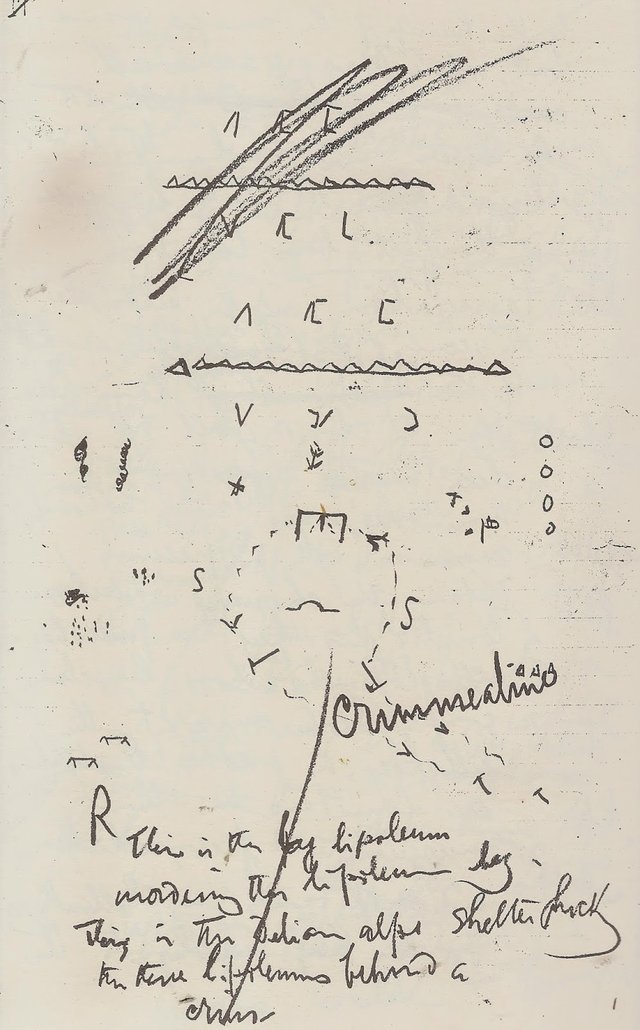
HCE and ALP
The opening lines of this paragraph allude to the love of HCE and ALP, which is the axis about which Finnegans Wake rotates, just as Ulysses revolves around the love of Leopold and Molly Bloom. Joyce once claimed that there was no connection between Finnegans Wake and his other works (Ellmann 695), but this is not entirely true. Finnegans Wake is continually alluding to earlier works in Joyce’s œuvre. In Ulysses, for instance, Bloom woos Molly on the Hill of Howth:
Touched his sense moistened remembered. Hidden under wild ferns on Howth. Below us bay sleeping sky. No sound. The sky. The bay purple by the Lion's head. Green by Drumleck. Yellowgreen towards Sutton. Fields of undersea, the lines faint brown in grass, buried cities. Pillowed on my coat she had her hair, earwigs in the heather scrub my hand under her nape, you'll toss me all. O wonder! Coolsoft with ointments her hand touched me, caressed: her eyes upon me did not turn away. Ravished over her I lay, full lips full open, kissed her mouth. Yum. Softly she gave me in my mouth the seedcake warm and chewed. Mawkish pulp her mouth had mumbled sweet and sour with spittle. Joy: I ate it: joy. Young life, her lips that gave me pouting. Soft, warm, sticky gumjelly lips. Flowers her eyes were, take me, willing eyes. Pebbles fell. She lay still. A goat. Noone. High on Ben Howth rhododendrons a nannygoat walking surefooted, dropping currants. Screened under ferns she laughed warmfolded. Wildly I lay on her, kissed her; eyes, her lips, her stretched neck, beating, woman’s breasts full in her blouse of nun’s veiling, fat nipples upright. Hot I tongued her. She kissed me. I was kissed. All yielding she tossed my hair. Kissed, she kissed me (Joyce 1922:167-168)
This episode is clearly echoed in the present paragraph. Just as Bloom retreats from his depressing present—on Bloomsday he buries an old friend and is cuckolded—into a happier past, so the widowed old landlord of The Mullingar House dreams of happier times, when he was young and newly wed.
Note the foliation of allusions in this paragraph to the Brontës, a literary family of Irish extraction. The father of the Brontë sisters was Patrick Brunty, an Anglican clergyman from County Down. Charlotte Brontë’s novel Villette is set in Brussels, close to the Battlefield of Waterloo. The only explanation I can give for their inclusion here is the association of the Greek word βροντή [brontē], which means thunder, and Brontë. The Museyroom episode has a Viconian structure, so it is entirely fitting that the voice of God, the thunder, should be heard at its outset.
It is also fitting that the landscape should be wet (Anna Rayiny, when unda her brella, mid piddle med puddle), as we are at the beginning of the post-Diluvial age. I mentioned in an earlier article how Finnegans Wake ends with the flooding of the Liffey, just as Richard Wagner’s operatic tetralogy Der Ring des Nibelungen ends with the flooding of the Rhine. Hence the allusions to Noah’s rainbow in the opening pages and the fact that the ground is still wet the following morning. It is also significant that torrential rain on the previous day delayed the Battle of Waterloo, ensuring Napoleon’s defeat.
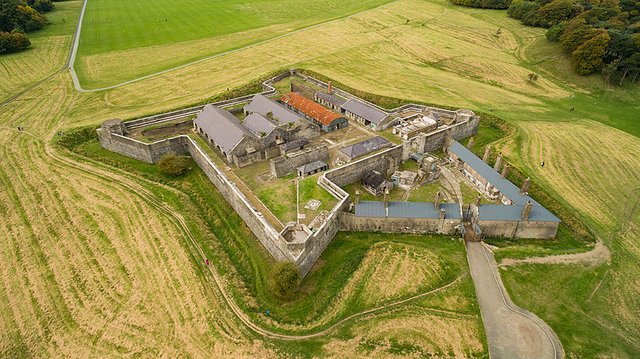
HCE’s Crime and Punishment
At the centre of this paragraph is the Fall of Man and HCE’s crime, which we looked at briefly in an earlier article. The source of HCE’s guilt is never clearly spelled out for us. It usually involves some incestuous or sexual misdemeanour involving two girls (ie Issy, his schizophrenic daughter). Either HCE exposes himself to them or he peeps at them when they are at their toilet (with obvious associations between micturition and the Flood). The scene of this Original Sin is typically the Phoenix Park, standing in for the Bible’s Garden of Eden.
HCE’s crime, whatever it is, is usually witnessed by a trio of soldiers, who lie in ambush. These are HCE’s two sons Shem and Shaun, who represent the two irreconcilable sides of HCE’s own nature, and the Oedipal figure (called Shimar Shin in the Museyroom episode), who represents Shem and Shaun reconciled. It is because HCE is guilty that he is preordained to be overthrown and replaced by this Oedipal figure, who thereby becomes the new HCE. But the new HCE will eventually repeat the crimes of the old HCE and be replaced in turn by a new Oedipus. And so the Viconian cycle continues ad nauseam et infinitum.
This trio of soldiers can also be associated with the two British soldiers, Privates Carr and Compton, who assault Stephen in Ulysses. Clearly, Joyce had Ulysses on his mind when he first drafted this paragraph.
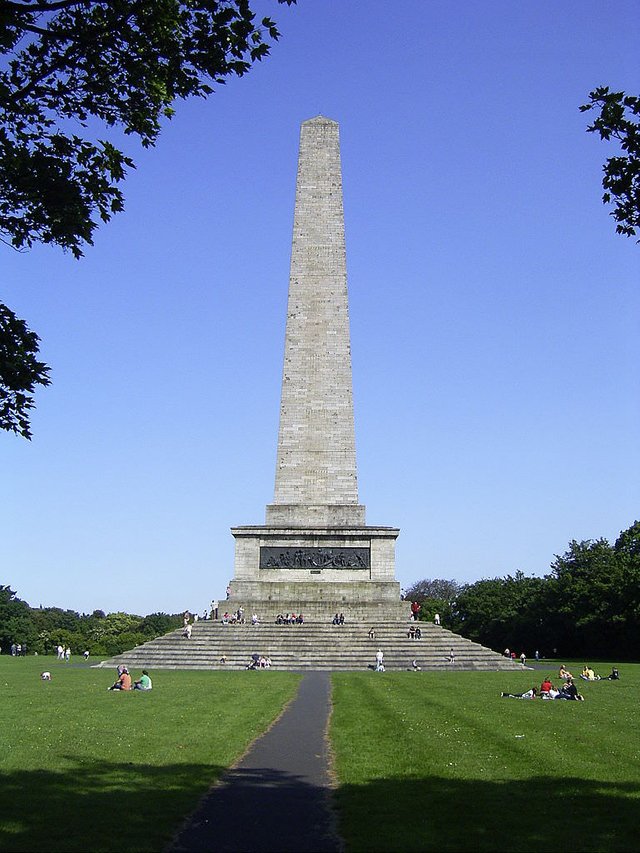
Waterloo
In the closing lines of this paragraph, the Dublin landscape metamorphoses into that of the battlefield of Waterloo. The Wellington Monument becomes at once:
The National Museum of Ireland: the main section of the museum is on Kildare Street, but the Natural History Museum on Merrion Square may also be relevant. Note the reference to dinosaurs and ichthyosaurs at the beginning of this paragraph: brontoichthyan.
The Wellington Museum: a museum established at Mont St Jean near Waterloo by Sergeant-Major Cotton of the 7th Hussars, who fought in the Battle of Waterloo under Wellington. The museum no longer exists but it was visited by Victor Hugo, whose account of the battle in Les Misérables (Part II, Cosette, Book I, Waterloo, which comprises Chapters 60-78) is an important source for Joyce’s description of the battle in the Museyroom episode.
The Wellington Museum: a museum in Apsley House, 149 Piccadilly, Hyde Park Corner, London. This house was designed by Robert Adam (RFW 435.06: Adam’s mantel) between 1771-78. The Duke of Wellington bought it and enlarged it in 1817. The Wellington Gallery was built for his extensive collection of pictures, sculptures, furniture, silver, porcelain, caricatures, medals and memorabilia.
The Lion’s Mound: a large conical artificial hill located on the battlefield of Waterloo near the place where a musket ball hit the shoulder of William II of the Netherlands (the Prince of Orange) and knocked him from his horse during the battle. In a later draft of this paragraph, Joyce emended national museum to Williamstown national museum, a possible allusion to William of Orange, victor at the Battle of the Boyne, and a relation of the Prince. (Williamstown is also the former name of a residential suburb of Dublin between Booterstown and Blackrock, but this village was named for the 18th-century Counsellor William Vavasour.)
The Museyroom is all these and more. But the final line of this paragraph, in which we are told that Kate, the elderly slavey or general maid-of-all-work of The Mullingar House, holds the key to the museyroom, reveals to us that in the real world it is nothing more than the outhouse in the yard behind the sleeping landlord’s inn. A WC (water closet) or loo (possibly from the French l’eau the water, or lieu place), the outhouse naturally brings Waterloo to mind, and becomes the place (lieu) in which the battle is refought. The museum, or HCE’s mausoleum, now becomes the kitchen midden or rubbish tip in the backyard of the Mullingar House, where history lies buried, to be one day uncovered by the archaeologist’s trowel.
The Museyroom episode, then, can be read on several different levels. It is, at once:
A tour through a museum, like Jacob von Falke’s visit to the waxworks in Dublin, in which he heard the joke about Wellington and his horse.
A detailed account of the Battle of Waterloo, mixed up with various other salient moments drawn from the careers of both Wellington and Napoleon, and numerous other battles, such as the Battle of the Boyne.
A description of HCE urinating, defecating and masturbating in his outhouse. Remember how Bloom visits the outhouse in Ulysses?
A depiction of HCE and ALP making love—possibly the event in which Issy was conceived.
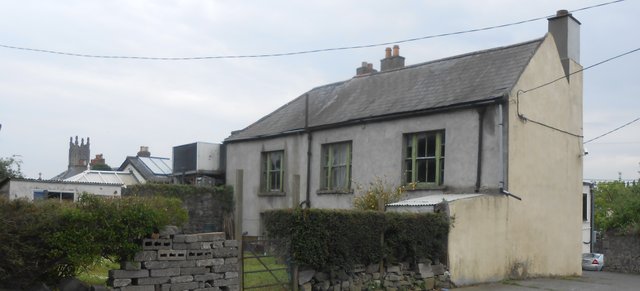
It should also be remembered that the back garden of the Mullingar House was once a bowling green (Jolas 159). In Laurence Sterne’s 18th-century novel Tristram Shandy, a key work for Finnegans Wake, Uncle Toby and Corporal Trim re-enact the Second Siege of Namur from the Nine Years’ War (the War of the League of Augsburg) on the bowling green at Shandy Hall. Many of the encounters of this war took place in the Spanish Netherlands, including the two sieges of Namur (1692 and 1695). Namur lies about 40 km to the southeast of Waterloo Battlefield.
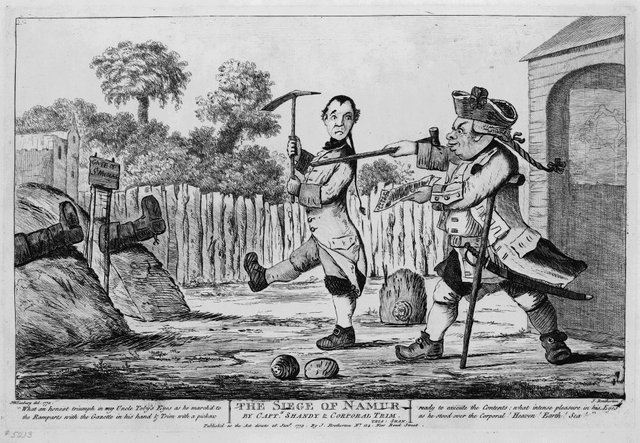
References
- Richard Ellmann, James Joyce, Second Edition, Oxford University Press, Oxford (1982)
- Victor Hugo, Les Misérables, Deuxième Partie, Cosette, J Hetzel, Paris (1862) – English Translation
- Maria Jolas, A James Joyce Yearbook, Transition Press, Paris (1949)
- James Joyce, Finnegans Wake, The Viking Press, New York (1958, 1966)
- Danis Rose, John O’Hanlon, The Restored Finnegans Wake, Penguin Classics, London (2012)
- Giambattista Vico, Goddard Bergin (translator), Max Harold Fisch (translator), The New Science of Giambattista Vico, Cornell University Press, Ithaca NY (1948)
- Jacob Von Falke, Lebenserinnerungen [Memoirs], Georg Heinrich Meyer, Leipzig (1897)
Image Credits
- Brontosaurus: Othniel Charles Marsh (illustrator), Public Domain
- Ichthyosaurus: Bericht der Senckenbergischen Naturforschenden Gesellschaft in Frankfurt am Main, Public Domain
- Joyce’s Sketch of the Battle of Waterloo: James Joyce (illustrator), Public Domain
- The Magazine Fort in the Phoenix Park: © Dronepicr, Creative Commons License
- The Wellington Monument in the Phoenix Park: © Mark Hill, Creative Commons License
- The Siege of Namur by Captain Shandy and Corporal Trim: Henry Bunbury (engraver), British Cartoon Collection, Library of Congress, Fair Use
Useful Resources
- Joyce Tools
- FWEET
- The James Joyce Scholars’ Collection
- FinnegansWiki
- James Joyce Digital Archive
- Annotated Finnegans Wake (with Wakepedia)
- From Swerve of Shore to Bend of Bay

Very interesting your historical research, congratulations.
Nice fantastic post friend congratulations
Friend a very interesting story excellent good contribution you share and bring to this great community success
i don't know how much i have learned from you, i sometimes think about how you know about all the history of these irisih erena